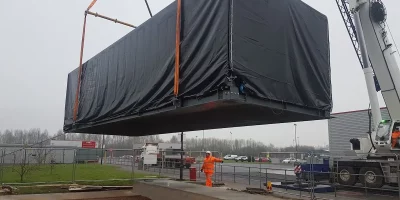Power is crucial for data centers to function properly and support their customers’ systems. Therefore, organizing and planning your systems’ energy usage should always be a top priority. Without power, businesses would come to a standstill.
Understanding power design and infrastructure can be challenging, especially for complex setups. When choosing a data center or colocation provider, it’s crucial to consider factors like location, security, and support. But one aspect that’s sometimes neglected is the power supply, which is highly significant.
What Is a Data Center?
In simple terms, a data center is a physical facility used by an organization to store and manage its essential applications and data. A data center’s structure depends on a network of computers and storage equipment that enables the exchange of applications and data.
A data center design includes routers, switches, firewalls, storage systems, servers, and application-delivery controllers as its key components.
Data Center Power
Data center power is vital for the operation of data centers. As with any other electronic device, data centers require electricity to function. With an uninterrupted power supply, a data center can operate.
Facilities managers must ensure that critical equipment in the data center always receives for energy use a steady supply of clean and uninterrupted electricity without exceeding the monthly electric bills.
Typical Data Center Power Infrastructure
Data centers usually rely on the municipal electric grid as their primary source of electricity. They use transformers to regulate the voltage and convert the current from AC to DC before using it. The number of transformers installed in a data center depends on its power requirements.
Some data centers use on-site electrical generation equipment like generators, solar panels, and wind turbines to make renewable energy to supplement or entirely replace power from the more comprehensive grid.
A UPS protects equipment from power surges and supplies power to multiple breakers. The number of servers connected to each breaker in a data center depends on the breaker’s capacity, power usage efficiency, and the server’s efficiency. Typically, up to seven or eight servers are connected per breaker in a standard data center setup.
UPS systems act as a primary backup in case of power outages or similar issues. They can provide power to servers, green data centers, and breakers for up to five minutes, allowing enough time to initiate backup generators immediately after an outage or grid issue.
Data Center Power Terminology
Two types of power circuits can power your servers, switches, routers, and other IT equipment and infrastructure: Alternating Current (AC) and Direct Current (DC).
Alternating Current (AC) Power Circuits
AC power circuits are commonly used for colocation customers, particularly for enterprise rack-mounted servers and storage devices. AC allows the polarity or direction of voltage or current to change over time.
Direct Current (DC) Power Circuits
Thomas Edison advocated using Direct Current (DC) power circuits during the electricity war. DC power differs from AC power in that it only flows in one direction rather than switching.
When you use batteries for your laptop or phone, you use Direct Current power. Direct Current power circuits are also found in most data centers, especially Uninterruptible Power Supply (UPS) systems. UPS is used to switch power sources from the utility power grid to diesel generators in case of a power outage.
Ampere (Amp)
Amps, or Ampere (“Amp”), are the electromagnetic force between electrical conductors carrying an electric current. Amps represent the electricity flowing through your devices, such as servers and other equipment.
All your electronic devices, including laptops and servers, require a certain amount of electric current measured in amperes (amps) to function.
Volt (V)
The definition of voltage is the measure of electric potential difference between two locations and is expressed in volts (V), equal to one joule per coulomb.
Volts are the force that drives electricity from the source to the endpoint, similar to pressure. Voltage measures electricity in batteries and power circuit breakers, varying from 1.5V to 110V, 120V, or 208V.
Watt (W)
A Watt (W), which is short for Wattage, measures energy efficiency, the speed at which energy is used. It represents the amount of power consumed by your electrical device. To calculate Watts, you must multiply Volts by Amps, giving you the final value.
If your rack uses a 208V/30A power circuit to power its servers and networking equipment, its total capacity is 6,240W.
Kilowatt (kW)
The unit of measurement for electricity, known as Kilowatt (kW), is widely accepted worldwide. It is equivalent to 1,000 watts. Therefore, you can convert watts to kilowatts by dividing the value by 1,000.
As seen in the previous instance, the 208V/30A power circuit produced a power of 6,240W. To obtain the power in kilowatts, you need to divide by 1,000. Therefore, 6,240 divided by 1,000 equals 6.24kW.
The unit kW helps you calculate your electrical devices’ overall power or energy consumption or the amount of power they need.
Kilowatt Hours (kWh)
If your electrical devices are powered on for one hour, two hours, or 24 hours a day, how many kilowatts are they consuming? A Kilowatt Hour (kWh) is a unit used to measure the number of kilowatts your electrical device uses within a specific period of power usage effectiveness.
Utility companies charge customers based on how much power they use and how much energy they use, measured in Kilowatt Hours (kWh).
Kilovolt Amps (kVA)
A Kilovolt Amp (kVA) is a unit used to measure the apparent power of an electrical circuit. It is equivalent to 1,000 volt-amps and is often utilized in generators and transformers to determine power output.
Single-Phase vs. Three-Phase Power
Single-phase power is supplied through only one conductor and is a more straightforward and more cost-effective design. In addition, it is the most energy-efficient, for a capacity of up to 1,000W, and has a maximum voltage of 230V.
Three-phase power consists of three separate wave cycles that flow through three conductors. It requires three or four wires and has a maximum voltage of 415V.
Data centers and colocation providers typically offer racks with a single-phase AC power circuit. However, certain data center industry providers may offer AC power circuits with three phases for colocation racks that need high density.
Megawatts (MW)
In the data center energy industry, megawatts are designated explicitly for wholesale colocation customers who need a lot of power to support thousands of servers and related IT hardware. A Megawatt is equivalent to 1,000 kilowatts or 1,000,000 watts and is abbreviated as MW.
High wholesale colocation costs depend on wholesale electricity rates with an additional markup for buildout costs, infrastructure, and cooling expenses. The price of wholesale power for colocation can vary from £.04 to £.09 per kWh based on the provider, location, and facility.
Best Practice For Data Center Power Design
Isolating Redundant And Non-Redundant Loads
If you have equipment with only one power cord, it’s best to separate the power and data cables. Then, you can use a static transfer switch when you use the equipment. Mixing both wires in a single cabinet is common, but separating them can prevent potential issues.
Backup Generators
It’s important to note that your backup power system’s standby rating should not be your design target. Instead, it would help if you aimed for something closer to the excellent rating.
Breaker Coordination and Ground Fault Protection
The technology in breakers and panels has advanced to allow better modeling of faulty breakers. Additionally, it is possible to have ground leakage protection units at the branch T breaker level.
Lightning Protection
It is essential to prioritize utility protection, especially the installation of surge protection devices on panels for any utilities entering or leaving the building. Additionally, ensuring lightning protection throughout the facility is recommended as best practice.
Uninterruptible Power Supplies
Which systems require UPS and which do not? It mainly depends on the density of the operation. For example, at TRG, UPS controls the crack unit systems to eliminate rebooting time post-transferring to a generator.
Batteries
The battery selection process often needs to be understood in the industry. For example, according to IEEE standards, a battery should be capable of providing power to a load for a specific duration, typically between 5-8 minutes, before it reaches the end of its life.
You should also consider the battery’s performance and ability to take energy demand and deliver power immediately.
Invest Money in the Right Areas
A key lesson to learn is investing more money in the right areas is essential. However, trying to save money by skimping on important components can ultimately result in more difficulties and additional expenses in the future.
To find out more, you can reach out to us here.






